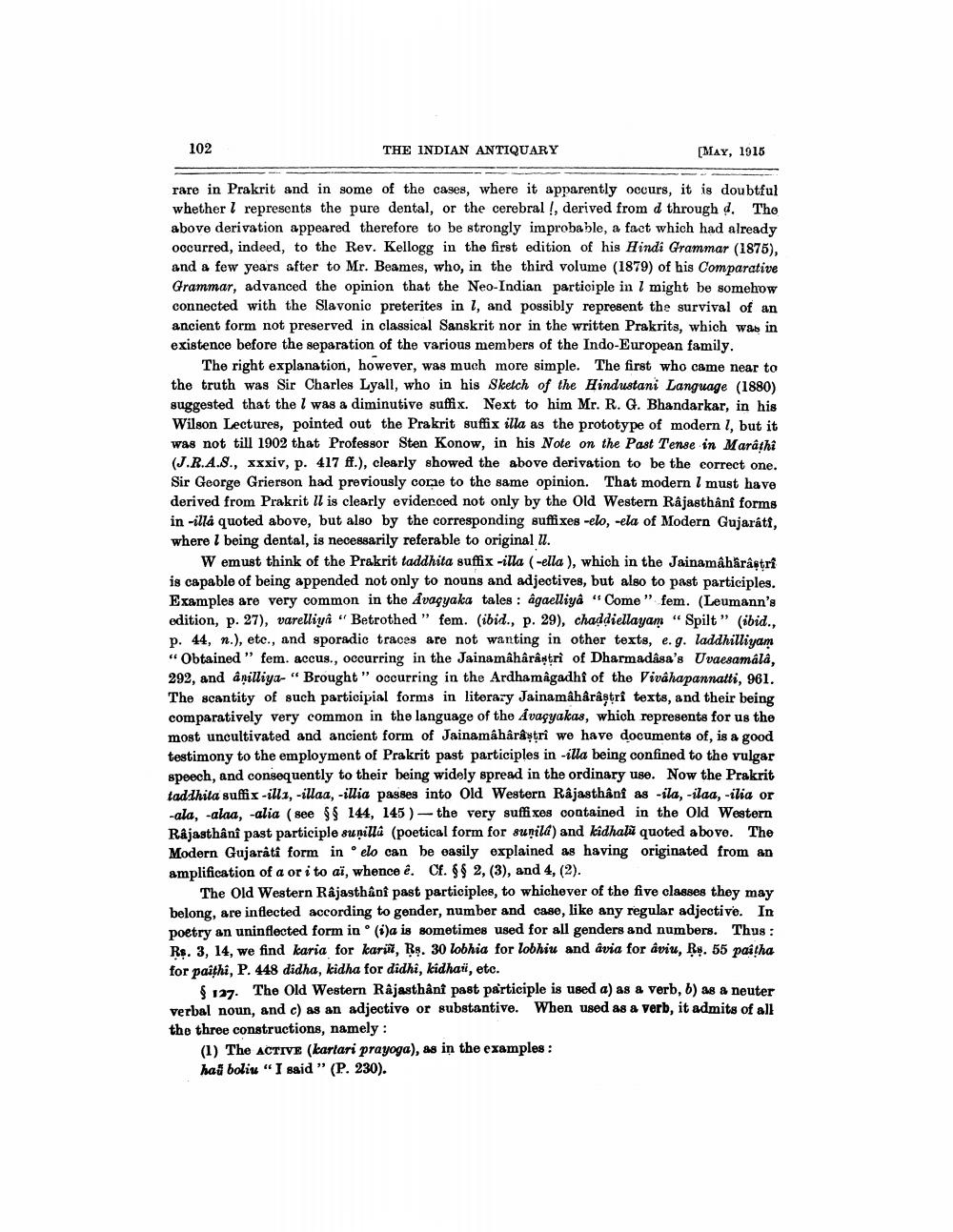________________
102
THE INDIAN ANTIQUARY
[MAY, 1915
rare in Prakrit and in some of the cases, where it apparently occurs, it is doubtful whether l represents the pure dental, or the cerebral !, derived from d through d. Tho above derivation appeared therefore to be strongly improbable, a fact which had already occurred, indeed, to the Rev. Kellogg in the first edition of his Hindi Grammar (1875), and a few years after to Mr. Beames, who, in the third volume (1879) of his Comparative Grammar, advanced the opinion that the Neo-Indian participle in I might be somehow connected with the Slavonic preterites in 1, and possibly represent the survival of an ancient form not preserved in classical Sanskrit nor in the written Prakrits, which was in existence before the separation of the various members of the Indo-European family.
The right explanation, however, was much more simple. The first who came near to the truth was Sir Charles Lyall, who in his Sketch of the Hindustani Language (1880) suggested that the I was a diminutive suffix. Next to him Mr. R. G. Bhandarkar, in his Wilson Lectures, pointed out the Prakrit suffix illa as the prototype of modern l. but it was not till 1902 that Professor Sten Konow, in his Note on the Past Tense in Marathi (J.R.A.S., xxxiv, p. 417 ff.), clearly showed the above derivation to be the correct one. Sir George Grierson had previously come to the same opinion. That modern l must have derived from Prakrit Il is clearly evidenced not only by the Old Western Rajasthani forms in illa quoted above, but also by the corresponding suffixes -elo, -ela of Modern Gujarati. where l being dental, is necessarily referable to original Il.
Wemust think of the Prakrit taddhita suffix -illa (-ella ), which in the Jainamaharastri is capable of being appended not only to nouns and adjectives, but also to past participles. Examples are very common in the Avagyaka tales : âgaelliya "Come" fem. (Leumann's edition, p. 27), varelliya "Betrothed ” fem. (ibid., p. 29), chaddiellayam" Spilt" (ibid.. p. 44, n.), etc., and sporadic traces are not wanting in other texts, e.g. laddhilliyam " Obtained " fem. accus., occurring in the Jainamâhârâmtri of Dharmadasa's Uvaesamála, 292. and anilliya-"Brought" occurring in the Ardhamagadhi of the Vivahapannatti, 961. The scantity of such participial forms in literary Jainamâhârâştri texts, and their being comparatively very common in the language of the Avagyakas, which represents for us the most uncultivated and ancient form of Jainamáhârâștrî we have documents of, is a good testimony to the employment of Prakrit past participles in -illa being confined to the vulgar speech, and consequently to their being widely spread in the ordinary use. Now the Prakrit taddhita guffix-illu, -illaa, -illia passes into Old Western Rajasthani as -ila, -ilaa, -ilia or -ala, -alaa, -alia (see $$ 144, 145 )-the very suffixes contained in the Old Western Rajasthani past participle suņilla (poetical form for suņild) and kidhalù quoted above. The Modern Gujarati form in elo can be easily explained as having originated from an amplification of a or i to aï, whence é. CF. $$ 2, (3), and 4, (2).
The Old Western Rajasthani past participles, to whichever of the five classes they may belong, are inflected according to gender, number and case, like any regular adjective. In poetry an uninflected form in (i)a is sometimes used for all genders and numbers. Thus : Rs. 3, 14, we find karia for karin, Rs. 30 lobhia for lobhiu and avia for avir, Ry. 55 paitha for paithi, P. 448 didha, kidha for didhi, kidhaii, etc.
127. The Old Western Rajasthani past participle is used a) as a verb, b) 28 a neuter verbal noun, and c) as an adjective or substantive. When used as a verb, it admits of all the three constructions, namely:
(1) The ACTIVE (karlari prayoga), as in the examples : had bolige " I said " (P. 230).




